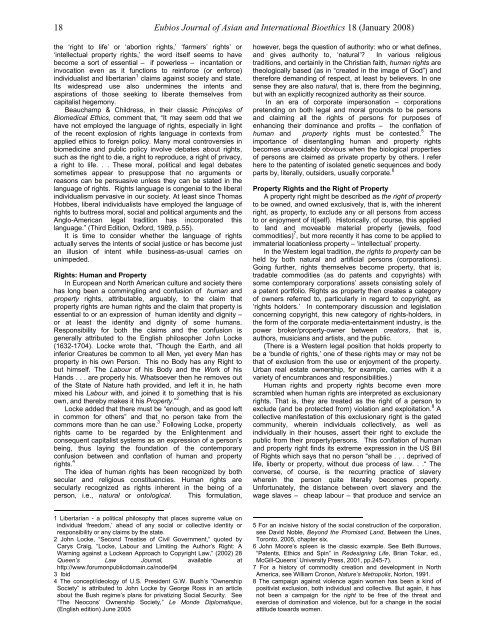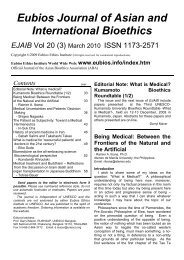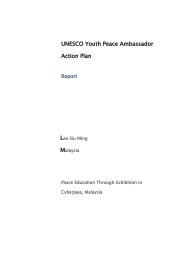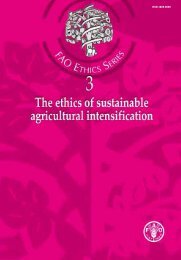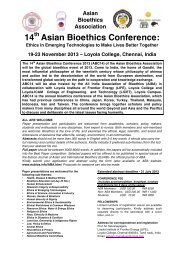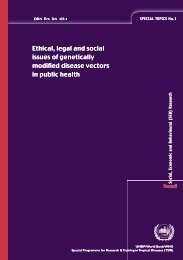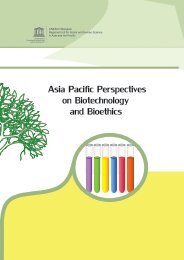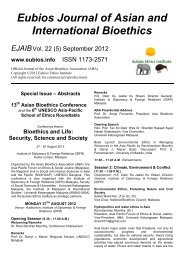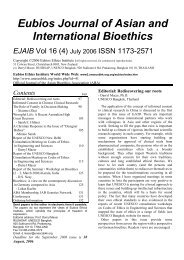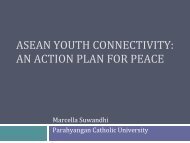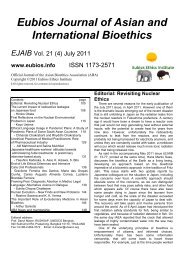Eubios Journal of Asian and International Bioethics EJAIB
Eubios Journal of Asian and International Bioethics EJAIB
Eubios Journal of Asian and International Bioethics EJAIB
- No tags were found...
You also want an ePaper? Increase the reach of your titles
YUMPU automatically turns print PDFs into web optimized ePapers that Google loves.
18<strong>Eubios</strong> <strong>Journal</strong> <strong>of</strong> <strong>Asian</strong> <strong>and</strong> <strong>International</strong> <strong>Bioethics</strong> 18 (January 2008)the ‘right to life’ or ‘abortion rights,’ ‘farmers’ rights’ or‘intellectual property rights,’ the word itself seems to havebecome a sort <strong>of</strong> essential – if powerless – incantation orinvocation even as it functions to reinforce (or enforce)individualist <strong>and</strong> libertarian 1 claims against society <strong>and</strong> state.Its widespread use also undermines the intents <strong>and</strong>aspirations <strong>of</strong> those seeking to liberate themselves fromcapitalist hegemony.Beauchamp & Childress, in their classic Principles <strong>of</strong>Biomedical Ethics, comment that, “It may seem odd that wehave not employed the language <strong>of</strong> rights, especially in light<strong>of</strong> the recent explosion <strong>of</strong> rights language in contexts fromapplied ethics to foreign policy. Many moral controversies inbiomedicine <strong>and</strong> public policy involve debates about rights,such as the right to die, a right to reproduce, a right <strong>of</strong> privacy,a right to life. . . These moral, political <strong>and</strong> legal debatessometimes appear to presuppose that no arguments orreasons can be persuasive unless they can be stated in thelanguage <strong>of</strong> rights. Rights language is congenial to the liberalindividualism pervasive in our society. At least since ThomasHobbes, liberal individualists have employed the language <strong>of</strong>rights to buttress moral, social <strong>and</strong> political arguments <strong>and</strong> theAnglo-American legal tradition has incorporated thislanguage.” (Third Edition, Oxford, 1989, p.55).It is time to consider whether the language <strong>of</strong> rightsactually serves the intents <strong>of</strong> social justice or has become justan illusion <strong>of</strong> intent while business-as-usual carries onunimpeded.Rights: Human <strong>and</strong> PropertyIn European <strong>and</strong> North American culture <strong>and</strong> society therehas long been a commingling <strong>and</strong> confusion <strong>of</strong> human <strong>and</strong>property rights, attributable, arguably, to the claim thatproperty rights are human rights <strong>and</strong> the claim that property isessential to or an expression <strong>of</strong> human identity <strong>and</strong> dignity –or at least the identity <strong>and</strong> dignity <strong>of</strong> some humans.Responsibility for both the claims <strong>and</strong> the confusion isgenerally attributed to the English philosopher John Locke(1632-1704). Locke wrote that, “Though the Earth, <strong>and</strong> allinferior Creatures be common to all Men, yet every Man hasproperty in his own Person. This no Body has any Right tobut himself. The Labour <strong>of</strong> his Body <strong>and</strong> the Work <strong>of</strong> hisH<strong>and</strong>s . . . are properly his. Whatsoever then he removes out<strong>of</strong> the State <strong>of</strong> Nature hath provided, <strong>and</strong> left it in, he hathmixed his Labour with, <strong>and</strong> joined it to something that is hisown, <strong>and</strong> thereby makes it his Property.” 2Locke added that there must be “enough, <strong>and</strong> as good leftin common for others” <strong>and</strong> that no person take from thecommons more than he can use. 3 Following Locke, propertyrights came to be regarded by the Enlightenment <strong>and</strong>consequent capitalist systems as an expression <strong>of</strong> a person’sbeing, thus laying the foundation <strong>of</strong> the contemporaryconfusion between <strong>and</strong> conflation <strong>of</strong> human <strong>and</strong> propertyrights. 4The idea <strong>of</strong> human rights has been recognized by bothsecular <strong>and</strong> religious constituencies. Human rights aresecularly recognized as rights inherent in the being <strong>of</strong> aperson, i.e., natural or ontological. This formulation,however, begs the question <strong>of</strong> authority: who or what defines,<strong>and</strong> gives authority to, ‘natural’? In various religioustraditions, <strong>and</strong> certainly in the Christian faith, human rights aretheologically based (as in “created in the image <strong>of</strong> God”) <strong>and</strong>therefore dem<strong>and</strong>ing <strong>of</strong> respect, at least by believers. In onesense they are also natural, that is, there from the beginning,but with an explicitly recognized authority as their source.In an era <strong>of</strong> corporate impersonation – corporationspretending on both legal <strong>and</strong> moral grounds to be persons<strong>and</strong> claiming all the rights <strong>of</strong> persons for purposes <strong>of</strong>enhancing their dominance <strong>and</strong> pr<strong>of</strong>its – the conflation <strong>of</strong>human <strong>and</strong> property rights must be contested. 5 Theimportance <strong>of</strong> disentangling human <strong>and</strong> property rightsbecomes unavoidably obvious when the biological properties<strong>of</strong> persons are claimed as private property by others. I referhere to the patenting <strong>of</strong> isolated genetic sequences <strong>and</strong> bodyparts by, literally, outsiders, usually corporate. 6Property Rights <strong>and</strong> the Right <strong>of</strong> PropertyA property right might be described as the right <strong>of</strong> propertyto be owned, <strong>and</strong> owned exclusively, that is, with the inherentright, as property, to exclude any or all persons from accessto or enjoyment <strong>of</strong> it(self). Historically, <strong>of</strong> course, this appliedto l<strong>and</strong> <strong>and</strong> moveable material property (jewels, foodcommodities) 7 , but more recently it has come to be applied toimmaterial locationless property – ‘intellectual’ property.In the Western legal tradition, the rights to property can beheld by both natural <strong>and</strong> artificial persons (corporations).Going further, rights themselves become property, that is,tradable commodities (as do patents <strong>and</strong> copyrights) withsome contemporary corporations’ assets consisting solely <strong>of</strong>a patent portfolio. Rights as property then creates a category<strong>of</strong> owners referred to, particularly in regard to copyright, as‘rights holders.’ In contemporary discussion <strong>and</strong> legislationconcerning copyright, this new category <strong>of</strong> rights-holders, inthe form <strong>of</strong> the corporate media-entertainment industry, is thepower broker/property-owner between creators, that is,authors, musicians <strong>and</strong> artists, <strong>and</strong> the public.(There is a Western legal position that holds property tobe a ‘bundle <strong>of</strong> rights,’ one <strong>of</strong> these rights may or may not bethat <strong>of</strong> exclusion from the use or enjoyment <strong>of</strong> the property.Urban real estate ownership, for example, carries with it avariety <strong>of</strong> encumbrances <strong>and</strong> responsibilities.)Human rights <strong>and</strong> property rights become even morescrambled when human rights are interpreted as exclusionaryrights. That is, they are treated as the right <strong>of</strong> a person toexclude (<strong>and</strong> be protected from) violation <strong>and</strong> exploitation. 8 Acollective manifestation <strong>of</strong> this exclusionary right is the gatedcommunity, wherein individuals collectively, as well asindividually in their houses, assert their right to exclude thepublic from their property/persons. This conflation <strong>of</strong> human<strong>and</strong> property right finds its extreme expression in the US Bill<strong>of</strong> Rights which says that no person “shall be . . . deprived <strong>of</strong>life, liberty or property, without due process <strong>of</strong> law. . .“ Theconverse, <strong>of</strong> course, is the recurring practice <strong>of</strong> slaverywherein the person quite literally becomes property.Unfortunately, the distance between overt slavery <strong>and</strong> thewage slaves – cheap labour – that produce <strong>and</strong> service an1 Libertarian - a political philosophy that places supreme value onindividual ‘freedom,’ ahead <strong>of</strong> any social or collective identity orresponsibility or any claims by the state.2 John Locke, “Second Treatise <strong>of</strong> Civil Government,” quoted byCarys Craig, “Locke, Labour <strong>and</strong> Limiting the Author’s Right: AWarning against a Lockean Approach to Copyright Law,” (2002) 28Queen’s Law <strong>Journal</strong>, available athttp://www.forumonpublicdomain.ca/node/943 Ibid4 The concept/ideology <strong>of</strong> U.S. President G.W. Bush’s “OwnershipSociety” is attributed to John Locke by George Ross in an articleabout the Bush regime’s plans for privatizing Social Security. See“The Neocons’ Ownership Society,” Le Monde Diplomatique,(English edition) June 20055 For an incisive history <strong>of</strong> the social construction <strong>of</strong> the corporation,see David Noble, Beyond the Promised L<strong>and</strong>, Between the Lines,Toronto, 2005, chapter six.6 John Moore’s spleen is the classic example. See Beth Burrows,“Patents, Ethics <strong>and</strong> Spin” in Redesigning Life, Brian Tokar, ed.,McGill-Queens’ University Press, 2001, pp.245-7).7 For a history <strong>of</strong> commodity creation <strong>and</strong> development in NorthAmerica, see William Cronon, Nature’s Metropolis, Norton, 1991.8 The campaign against violence again women has been a kind <strong>of</strong>positivist exclusion, both individual <strong>and</strong> collective. But again, it hasnot been a campaign for the right to be free <strong>of</strong> the threat <strong>and</strong>exercise <strong>of</strong> domination <strong>and</strong> violence, but for a change in the socialattitude towards women.


